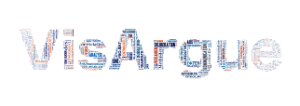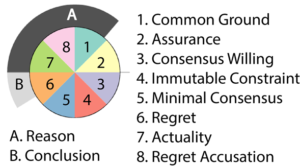 Political scientists, linguistis and computer scientists at the University of Konstanz developed an automatic system for the analysis and visualization of political communication. Their software – a result of the interdisciplinary BMBF-funded project VisArgue – allows to draw conclusions with respect to the deliberative quality of political discourse. One use case is the Stuttgart 21 mediation which took place in 2010 and aimed at resolving the conflicts around the railway and urban development project in Stuttgart (Germany).
Political scientists, linguistis and computer scientists at the University of Konstanz developed an automatic system for the analysis and visualization of political communication. Their software – a result of the interdisciplinary BMBF-funded project VisArgue – allows to draw conclusions with respect to the deliberative quality of political discourse. One use case is the Stuttgart 21 mediation which took place in 2010 and aimed at resolving the conflicts around the railway and urban development project in Stuttgart (Germany).
While consensus-oriented and participatory processes are increasingly used to resolve conflicts between policy makers and civil society, research has only scarcely dealt with these democratic innovations. The task in the VisArgue project was to determine the characteristics of deliberative communication and develop an automatic analysis system that can manifest deliberative quality in political dialogues. To that end, political science determined four dimensions that are relevant for deliberation:
- Participation – How much do participants contribute to the debate?
- Atmosphere & Respect – Are participants polite? What emotions are used?
- Argumentation & Justification – How and how often do particpants argue?
- Accommodation – Are particpants aiming for a consensus?
The analysis system comprises of more than 50 measures, whereby some of them are generated via statistical methods, for example the expected probability to speak. The majority of measures, however, is based on linguistic patterns found in the debates, such as speech acts that signal consensus or phases of bargaining. More importantly, we analyse patterns of argumentation, for instance whether participants bring forward reasons for the conclusions, mention condition to consequences, or oppose information that was mentioned in the previous debate. In order to provide a high-quality analysis of the data, we use a rule-based annotation system that automatically identifies, disambiguates and annotates lexical items, and can be applied across German debate data.
In order to interpret the data, VisArgue makes use of information visualization. With a total of twelve visualization, for instance via Lexical Episode plots that visualize the topics under discussion in the debate, the project sheds light on various properties of the debate.
One of the central visualizations is the argumentation glyph, an abstract representation of speaker stances and argumentation contained in an utterance. The outer segments of the glyph capture the relative amount of argumentation, i.e. text units of reason and conclusion that are found in the utterance. The speaker stances extracted from the text are mapped to equally-sized circle-segments in the inside of the glyph.
The figure below shows the glyph representation for a number of utterances of three S21 participants. For the moderator, Heiner Geißler, the following patterns emerge: He consistently refers to the knowledge shared between discussion partners (Common Ground), indicating that the discussion content is already known to the participants. Moreover, he tries to achieve mutual consent between the conflicting parties (Consensus Willing).
The detailed view on the underlying data and the position of the glyph in the mediation is shown in the next figure. This pattern for instance differs to those found for Volker Kefer, a proponent of S21, who repeatedly uses assurance when contributing to the discussion.
Overall, the are several possible avenues for future work: For one, the system will be extended to deal with English text, using the same underlying annotations as for the German data. We will also provide a more detailed of the kinds of arguments that are exchanged in the debates and how they influence the subsequent debate. Another possibility is to turn the system into a “live” analysis system that can run in parallel to a debate, analyzes the deliberative quality of the ongoing discourse and thereby supports participants in making these kinds of democratic processes more successful and efficent.
VisArgue Members: Valentin Gold, Katharina Holzinger (Political Science), Tina Bögel, Annette Hautli-Janisz, Maike Müller, Miriam Butt (Linguistics) and Mennatallah El-Assady, Christian Rohrdantz and Daniel Keim (Computer Science)




